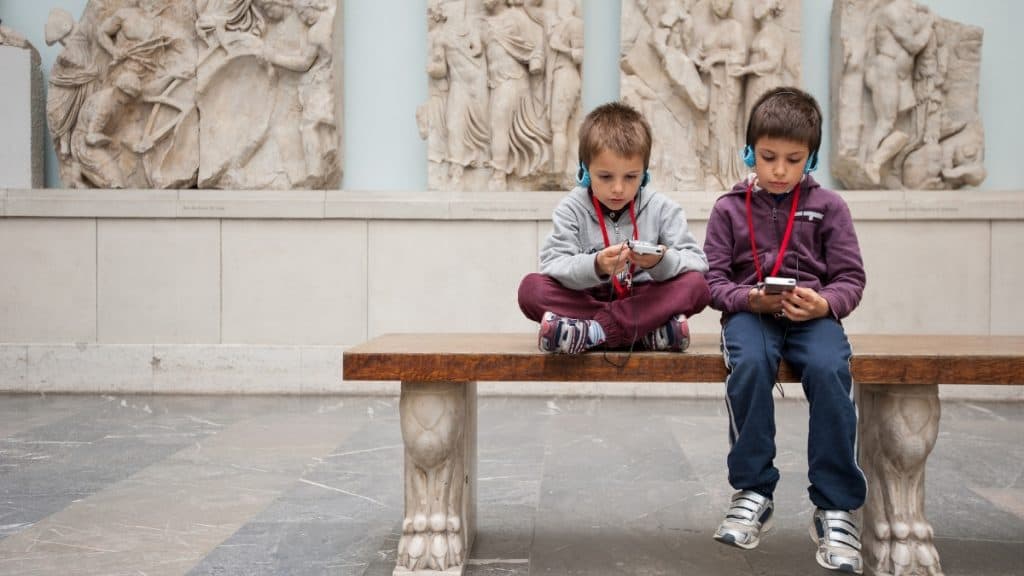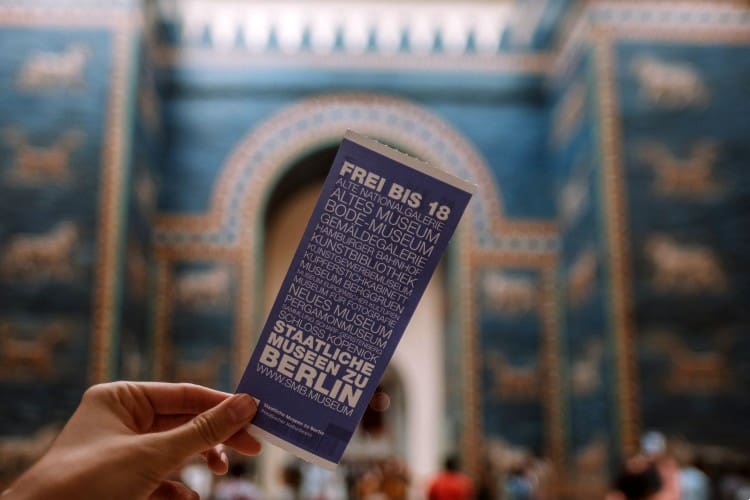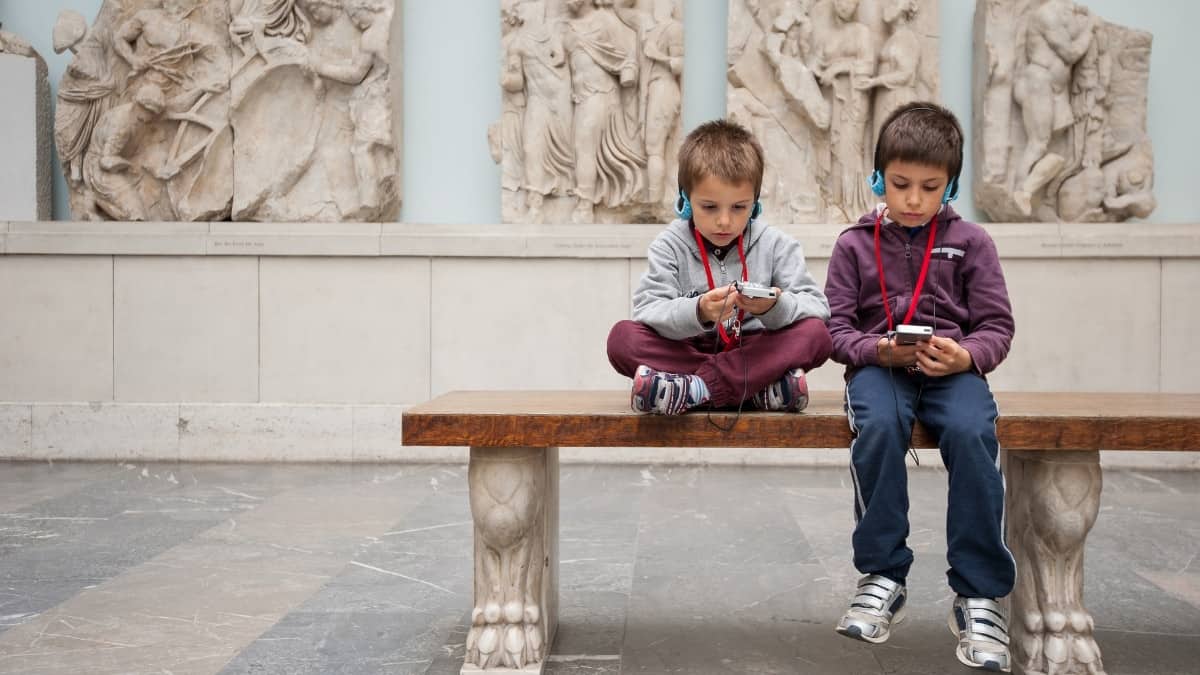
Pergamon Museum is the biggest and most spectacular Museum on Museum Island in Berlin.
Named after the ancient Greek city of Pergamon, it is also the most visited museum in Germany.
Pergamon Museum is known for its stunning reconstructions of massive ancient structures such as the Pergamon Altar, the Ishtar Gate, the Processional Way from Babylon, the Market Gate Miletus, and the Mshatta facade.
This article covers everything you must know before buying your Pergamon Museum ticket.
Top Pergamon Museum Tickets
# Pergamon Museum tickets
# Guided tour of Pergamon Museum
# Berlin Museum Island Pass
Table of Contents
What to see at the Pergamon Museum
Pergamon Museum has lots of fascinating exhibits on display.
Pergamon Museum is broadly divided into three parts – Ancient World, Greek and Roman antiquity, and Islamic Art & Culture.
Ancient World
- Ishtar Gate of Babylon
- Processional Street of Babylon
- Central Assyrian law table
- Facade of the Prince’s Palace from Tell Halaf
Greek and Roman antiquity
- Pergamon Altar
- Miletus Market Gate
- Praying Boy
Islamic Art & Culture
- Alhambra Dome
- Mshatta facade
- Eagle Aquamaile
- Aleppo Room
Until 2024, the Pergamon museum is completely closed due to construction work. Only Das Panorama, the Panorama exhibition by Yadegar Asisi, is open for visitors.
Pergamon Museum tickets
This Pergamon Museum priority access ticket helps you skip the long lines at the entrance.
Besides the Pergamon Museum, this ticket also gets you skip the line entry to the Panorama exhibition by Yadegar Asisi.
Panorama exhibition is in a building next to the Pergamonmuseum and offers a full-circle view of the Graeco-Roman city of Pergamon in the year 129 AD. More about Das Panorama
Visitors 18 years and below get free entry, but you must still mention them while booking your tickets.
Ticket price
Adult ticket (18+ years): 12 Euros
Student ticket (with student ID): 6 Euros
Disabled ticket: 6 Euros
Das Panorama, the Panorama exhibition by Yadegar Asisi, is open for visitors.
Guided tour of Pergamon Museum
During this 3-hour guided tour, a local expert takes you around the Pergamon Museum and New Museum.
It is popular amongst history aficionados because they explore the wonders of ancient Egypt, Babylon, Greece, and Rome under the guidance of an expert.
Once the guided tour is over, the local guide hands over a Museum Island day pass with which you can explore the other three Museums by yourself.
Tour price
Adult ticket (18+ years): 59 Euros
Child ticket (up to 17 years): 39 Euro
Berlin Museum Island Pass
Berlin Museum Island Pass offers access to all the five Museums on the Island.
Museum Island Pass is perfect for two kinds of tourists – those who want to visit all the Museums on the Island and those who aren’t sure which Museum they wish to visit.

The Pass gets you skip-the-line access to the Bode Museum, Altes Museum, and Alte Nationalgalerie – you can show it on your smartphone and walk into these Museums.
However, at the Neues Museum and Pergamon Museum, you must stand in a line to get a physical ticket before you can enter. You won’t have to pay for anything.
Once activated, this Museum Island Pass is valid for one whole day.
Buy Museum Island PassHow to reach the Pergamon Museum
Pergamon Museum is located on the Museum Island.
Address: Bodestraße 1-3, 10178 Berlin, Germany. Get Directions
You can reach the attraction both by public or private transport.
By subway
You can board U6 Line and get to the Friedrichstrasse U station, which is closest to the Museum Island.
The Subway is 700 meters (half a mile) from Pergamon Museum, and you can walk the distance in 8 to 10 minutes.

You can board S-Bahn lines S1, S2, S25, S5, S7 or S75 and reach either Berlin Friedrichstraße station or Hackescher Markt station.
Hackescher Markt station is 1 km (0.6 miles) from Pergamonmuseum, and you can walk the distance in 12 to 15 minutes.

By Tram
You can take the Trams M1 and M12 and get down at AM Kupfergraben tram stop.
It is 300 meters (one-fifth of a mile) from the Museum, and by walk, you can reach your destination in five minutes.
By Bus
If you prefer a bus, you can board Bus Number 100 or Bus Number 200 and get down at Lustgarten.
Lustgarten is a park on Museum Island.
Pergamon Museum is 600 meters from Lustgarten, and you can walk the distance in 8 to 10 minutes.
By car
If you’re traveling by car, turn on your Google Maps and get started.
There is no on-site car parking available. However, you can park at either Radisson Blu Hotel or International Trade Center.
Opening hours of Pergamon Museum
From Friday to Wednesday, the Pergamon Museum is open from 10 am to 6 pm.
On Thursdays, the Museum stays open till 8 pm.
The last admission is 30 minutes before the Museum closes.
How long does the Pergamon Museum take
Visitors in a rush can explore Pergamon Museum’s highlights in an hour.
To explore all the three wings of the Museum, you need at least two hours.
History buffs are known to spend upwards of four hours at Germany’s most famous Museum.
Best time to visit Pergamon Museum
The best time to visit the Pergamon Museum is as soon as they open at 10 am.
The crowd is at its minimum, which means you can take time exploring the exhibits and take better photographs.
It starts getting crowded after 11 am, and between 12 and 2 pm, the Museum reaches its peak capacity.
If you can’t make it early in the morning, the next best time to visit Pergamonmuseum is after 2 pm.
Where is the Pergamon Museum
Pergamon Museum is on Musuem Island in Berlin.
The Pergamon Panorama is right outside the Island, a walkable distance.

Pergamon Museum entrance
Entry to Pergamonmuseum is exclusively through the newly built James Simon Gallery visitor center.
Everyone must use the big stairway (see map below) and meet at the Information Desk in the Upper Foyer of James Simon Gallery.

Pergamon Museum for free
Till September 2010, the Pergamon Museum allowed free admission on Thursdays.
But not anymore.
However, it is possible to get free entrance into Pergamon Museum if you qualify any of the below conditions:
- Visitors up to 18 years of age
- School children on educational outings with their teachers
- University / college students accompanied by a lecturer
- Members of the International Council of Museums (ICOM) and the German Museums Association
- Journalists with press ID cards
- Persons in receipt of transfer benefits with valid documents
- Carers accompanying a severely disabled person where this requirement is noted in the disabled Pass
Pergamon Museum discounts
Visitors below 18 years of age get a 100% discount at the Pergamon Museum and thus enter for free. However, they must book a free ticket (you will find the option on the ticket booking page).
Students with a valid ID and visitors with a disability get a 50% discount on their Pergamon museum entry ticket and thus pay only 6 Euros.
However, seniors don’t get any reduction in the ticket price.
Pergamon Museum audio guide
Pergamon Museum in Berlin offers an audio tour, which you can pick up at the entrance.

Using the audio guide, you can walk through the Ishtar Gate, the Pergamon Altar, the beautiful streets of Babylon, etc. listening to expert commentary in multiple languages. Image: Tripadvisor
These audioguides are free with Pergamon Museum tickets.
Pergamon Museum virtual tour
If you would prefer a virtual tour of the Pergamon Museum before your actual visit, check out Google’s Art & Culture section on the Museum.
Pergamon Museum tour
Let’s walk you through the highlights of Berlin’s Pergamon Museum:
Ishtar Gate of Babylon
Robert Koldewey and Walter Andrae, two German archaeologists, found Ishtar Gate in what is now central Iraq, in the year 1899.
The glorious Ishtar Gate made up of colorful, vibrant glazed bricks and decorated with fantastic beasts was Babylon’s entrance built by Nebuchadrezzar II in the sixth century B.C.
Ishtar Gate was one of the several city gates on the wall around Babylon, counted among the ‘Seven Wonders of the World’.

The Gate walls depict wild bulls and snake-like dragons, representing Babylonian deities Adad and Mardukon, a bright blue background.
Don’t miss out on the reconstructed facade of King Nebuchadrezzar II’s throne room, which sits on the left of the Ishtar Gate.
Processional Street of Babylon
Gate of Ishtar was the entrance that led to the processional Street of Babylon.
The Processional Street of the ancient city of Babylon was an 800 meter long (half a mile) brick road connecting the outer city of Babylon to the Temple of Marduk.
Out of the 800 meters, only 180 meters of the path was richly decorated with ceramic glazed brick walls featuring ornate lions.

The Pergamon Museum has reconstructed a small section of the processional street, with reduced width.
Image: Museumsinsel-berlin.de
On both sides of the wall, you will see Lions on a blue background.
Central Assyrian law tablet
The Assyrian law tablet on display at Pergamon Museum was created during the rule of King Ninurta-apil-Ekur in Iraq (1191-1179 BC).
The 58 paragraphs on the tablet describe laws relating to clothing, criminal acts, women, matrimonial, and property.
This collection of Assyrian law is written in cuneiform, a writing system used by many Mesopotamian civilizations.
Facade of the Prince’s Palace from Tell Halaf

This is yet another massive exhibit at the Pergamon Museum, where three god sculptures rise on the backs of two lions and a bull to a total height of about six meters.
Image: Museumsinsel-berlin.de
This facade was part of the Hittite Palace built around the end of the 9th century BC, in what is now northern Syria.
Max Freiherr von Oppenheim excavated the facade of the Prince’s Palace and first displayed it in his own Tell Halaf Museum in Berlin.
However, after the Tell Halaf Museum burnt down (and most exhibits destroyed), the facade was restored and displayed at Pergamonmuseum.
Pergamon Museum’s Altar
The Pergamon Altar is perhaps the most famous item in the Pergamon Museum (and in the Altes Museum).
The Pergamon Altar is a massive structure built by King Eumenes II in the first half of the 2nd century BC on the acropolis Pergamon, an ancient Greek city.

In 1878, the German engineer Carl Humann initiated the official excavations on Pergamon’s acropolis.
At of 35.64 meters (117 feet) wide and 33.4 meters (109 feet) tall, it is a massive structure, and it took him eight years to complete the excavation.
Pergamon Altar’s base depicts the battle between the Giants and the Olympian gods, using hundreds of larger-than-life figures.
Since many historians feel this Altar honors both Zeus and Athena, it is often referred to as Pergamon Museum’s Zeus Altar.
It is because of this exhibit that the Museum gets its name – Pergamon Museum.
Miletus Market Gate
The Market Gate of Miletus is a large marble structure built around 100 AD, and is proof of the advancements in Roman cities.

The 17 meters (56 feet) high and 29 meters (95 feet) wide gate is believed to have fallen during an earthquake in the 10th or 11th century.
The gate’s fragments were recovered from excavations in Berlin between 1903 and 1905 and rebuilt at Pergamon Museum in the late 1920s.
Praying Boy
The ‘Praying Boy’ at the Pergamon Museum is one of the most famous ancient bronze statues.

Experts believe it was sculpted around 300 BC in the artistic style of Greek sculptor Lysippos, who lived in the 4th century BC.
It is challenging to identify Lysippos’s work because he had many students in his immediate circle who copied his style.
The fact that there was a market for copies of his kind of work resulted in many similar artworks.
Image: Merja Attia
After his victory over the Prussian Army in 1807, Napoleon took ‘Praying Boy’ to Paris. Twenty years later, it was back on display in Berlin.
Alhambra dome
The Alhambra Dome (locals call it the Alhambra Cupola) is a wooden ceiling carved from cedar and cottonwood and partly painted.
It was created in the early 14th century and was part of the oldest garden palaces of the famous Alhambra Castle in Granada.

The Alhambra Dome came to Germany as a gift from the Granada city in 1891 and has since been a property of the Museum.
The Dome is decorated with typical star patterns and has the quote – ‘There is no victor but God.’
Mshatta Facade
Mshatta Facade is the decorated part of the facade of the 8th-century residential palace of Qasr Mshatta of the Umayyad dynasty.

The desert palace of Mschatta was in what is now the Jordanian capital of Amman.
The highly decorated facade, measuring 35 meters (115 feet) in length, was a gift from Sultan Abdulhamid II to Emperor Wilhelm II.
Eagle Aquamanile
The Eagle Aquamanile is a vessel to pour water, created around AD 800 in Iraq.

The intricate details and the delicate patterns on the exhibit suggest it was created by one of the finest artisans of the era.
Image: Museumsinsel-berlin.de
Silver and copper inlay, which the coppersmiths of the Islamic world were known for, can also be spotted on this Eagle Aquamanile.
Aleppo Room
Aleppo Room at Pregmon Museum is part of a house found in the historic center of the Syrian city of Aleppo.

It is the oldest surviving wall paneling from the Ottoman Empire and gives us an idea of how rooms used to be designed in Arab countries, Turkey, and northern Iran.
Image: Lars Plougmann
The Aleppo Room is adorned with Arabic and Persian verses and delicate paintings of people, animals, mythical creatures, plants, ornaments, etc.
Pergamon Museum Panorama
The Pergamonmuseum Panorama is an exciting exhibition where visitors can see 3D representations of the ancient city of Pergamon.
Its official name is: PERGAMON. Masterpieces from the Ancient Metropolis with a 360° Panorama by Yadegar Asisi.
Erected in November 2018 opposite the Bode-Museum, on the Museum Island, this exhibition is on till 2024.
Visitors stand in the center and take in the 360-degree view of the ancient city as it could have looked in 129 AD during the reign of the Roman Emperor Hadrian.
The online Pergamon Museum tickets also include access to the Pergamon Museum Panorama.

Yadegar Asisi, the artist
Berlin-based artist Yadegar Asisi developed the concept for Pergamonmuseum Panorama.
He visualized how the city would be and used models to depict 40 everyday scenes possible in Pergamon.
All of this was printed on a 104 x 30 meter (341 x 98 ft.) photograph, which covers the exhibition building’s rotunda.
Pergamon Museum Cafe
Even though the Pergamon Museum Berlin doesn’t have a cafe, there are enough places to eat and drink within the Museum Island.
Café im at Bode-Museum
Café im at Bode-Museum offers seasonal sweets, savory snacks, cakes, etc. with many varieties of teas and coffees.
It is open from Tuesday to Sunday and closed on Mondays.
Even if you’re not visiting the Bode-Museum, you can still visit the café via the outdoor stairs.
Timings: The restaurant at Bode-Museum opens at 10 am daily and closes at 6 pm. On Thursday, it stays open till 6 pm.
Cafe Pi at Pergamonmuseum, The Panorama
Cafe Pi is in the building that also houses the 360° Panorama exhibition by Yadegar Asisi.
From Tuesday to Sunday, Cafe Pi is open from 10 am to 6 pm. It remains closed on Monday.
Café & Restaurant Cu29
Cu29 restaurant is in James Simon Gallery and opens daily from am till 11 pm.
If TripAdvisor users are to be believed, this is a Cafe to avoid.
Allegretto Cafe
Allegretto Café is at the Neues Museum, and from Tuesday to Sunday, it is open from 10 am to 6 pm.
It is on the 2nd floor of the Neues Museum and is an excellent place to take a break during your visit to the Museum.
